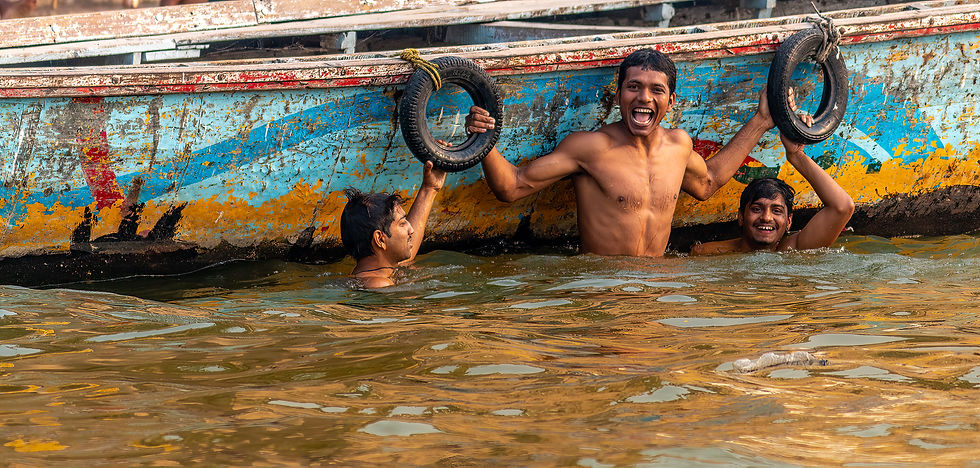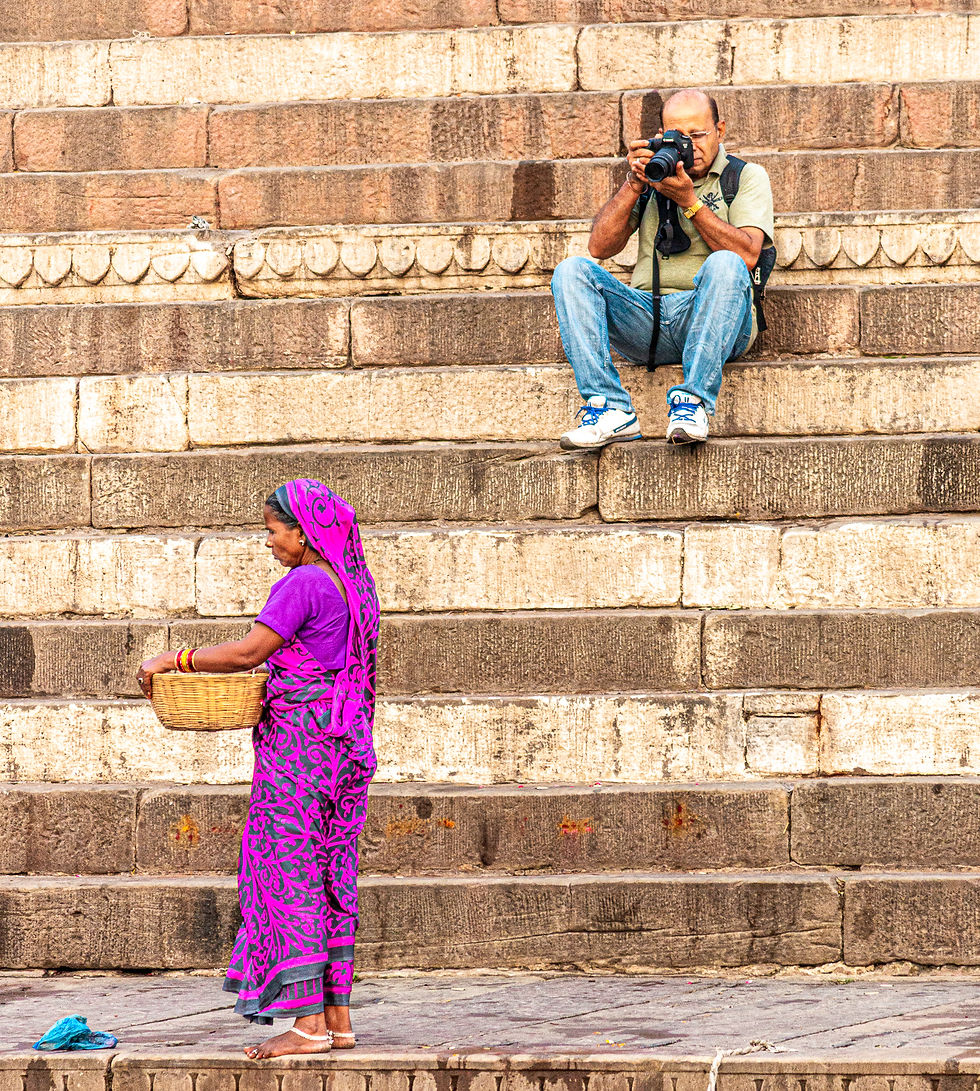Through the Lens: Varanasi Street Photography Tips
- Rand Blimes

- May 16
- 8 min read
Through the Lens posts offer a practical take on how I approach travel photography in the real world. The travel photographer’s most important skill? Flexibility. We shoot landscapes, portraits, architecture, wildlife, events, macro, food, fashion, fine art, sports—sometimes all within a 20-minute span. We document. We chase light. We tell stories in a single moment.
We often have to shoot handheld in low light, and yet we lug tripods across the globe.
These posts aren’t about gear or settings. They’re about how to see—how to think like a photographer when the scene in front of you is a glorious, chaotic mess that evolve faster than you can change your f-stop.
Below I describe what I was thinking in taking five different shots I made at Varanasi. Note there are a couple of themes running through these images. First, all these shots are of people. While Varanasi provides a wealth of subjects, it is the best people watching on the planet. In terms of framing, the most important thing is to zoom in to focus on a subject. I leave just enough of the surrounding area to provide a little context, but I made sure that the subject is fairly large in the frame.
1. THE BROOM CARRIER

This image is a good example of why photographing Varanasi is both thrilling and maddening. At first glance, the ghats seem like an easy win: bold lines, saturated color, endless human activity. But zoom out even a little, and the frame turns into a chaotic tangle—wires, signs, limbs, bricks, cows, boats, laundry, smoke. Visual clutter is the default setting.
Separately, each of these elements might make for a great image. But lump them all in together and you likely have a messy shot where the viewer’s eye has no idea where to go. And the last thing you want to do is make your viewers’ eyes feel confused.
This photo works because it cuts through the noise. It’s not just a photo of the ghats—it’s a photo of a man on the ghats. One man. That matters. The simplicity of a lone figure brings clarity to a scene that could otherwise dissolve into abstraction. There's a clean narrative: a worker with a broom, mid-step, framed by geometry.
Notice the subject placement. He’s on the left, facing right. That’s intentional. When someone is moving, you want to give them space to move into. It creates a sense of forward motion rather than boxing them in. It also balances the composition, letting the viewer’s eye flow with the subject rather than bounce back against him.
This was shot with a long lens—somewhere between 200mm and 400mm—which compresses the layers and removes distractions. Long lenses are a powerful tool in places like Varanasi because they let you isolate structure within chaos. You can sculpt order out of the mess.
What could have made it better?
It might have been even stronger if the subject’s stride were a bit more extended—a more dynamic walking pose—or if the broom’s bristles caught a hint of motion. Also, the box on the left isn’t doing much for the story. Waiting half a second for a slightly cleaner gap between him and that box might have helped. But honestly, in a place like Varanasi, capturing a clean frame at all feels like a small miracle.
2. JOY IN THE WATER

Zoom in. In a place like Varanasi, it’s not just good advice—it’s photographic survival.
This image works because the frame is tight. The backdrop—the battered, paint-chipped hull of a wooden boat—adds texture and context, but doesn’t overwhelm. The boys are the story here, and the long lens keeps them front and center. We don’t need to see all of Varanasi to understand this moment. We just need this moment: joy, play, motion, grit, and color.
If I’d zoomed out even a little bit, the frame would have flooded with noise: other swimmers, boat passengers, maybe a holy man or a tourist snapping selfies. That’s what Varanasi gives you—everything, all at once. The trick is not to photograph everything. The trick is to find a single, vibrant thread in the tapestry and pull it tight.
That’s why, like the previous image of the broom carrier, this was shot with a long lens. It lets you curate the scene. You still have context—the grime of the boat, the glint on the water, the tire rings—but none of it competes with the subjects. They own the frame.
What could have made it better?
There’s a floating plastic bottle in the foreground. Not a deal-breaker (and maybe even a tiny nod to realism), but it does pull the eye a bit. I made a conscious decision to not remove the bottle in Photoshop. It weakens the image a bit, but also makes it more true. Also, if I’d caught the splash or a water droplet mid-air, it could’ve added more energy to the image. Still, this one feels alive, and sometimes that’s enough.
3. HOLY MAN AT THE GHATS

Sometimes the shot is buried inside layers of chaos. In this case, I was standing in a crowd. There were people both in front of this sadhu and behind him. He wasn’t performing. He wasn’t facing me. He wasn’t even especially aware of the camera. But there was a stillness about him—an intensity—and I wanted to find a way to isolate that.
Zoom helped. This was taken with a long lens, letting me thread the needle between bodies. But the real trick was opening the aperture wide. That gave me a very shallow depth of field—blurring the distractions both in front of and behind him, like fog rolling over noise.
The result is a kind of tunnel vision: the sadhu is in sharp focus, his skin dusted in ash, his beard streaked gold, his posture quietly powerful. Everything else falls away. We see the scene the way I saw it in that moment—not the full environment, but the one subject who deserved our full attention.
This is a reminder: it’s not just about what’s in the frame, but how much of it is in focus. Shallow depth of field is one of the strongest tools you have for storytelling in crowded environments. It whispers to your viewer: “Look here. This matters.” This is not easy to pull off in a place like Varanasi. But when you do, you get something to be proud of.
What could have made it better?
I wish his hand hadn’t intersected the right edge of the frame—it feels a touch cropped. A tiny step to the left might have given a cleaner composition. But this scene opened up before me for literally only a couple of seconds. Travel photography is shooting from the hip and sometimes we don’t get the perfect framing we want. You have to learn to live with it.
4. FAMILY ON THE STRIPED GHATS

In a place as visually dense as Varanasi, it helps to stop looking for scenes and start looking for patterns.
This photo came together because of two key things: zoom and geometry. The ghat steps form strong horizontal stripes, alternating red and white like a weatherworn flag. Against that, the vertical presence of the man and two children pops. Their posture is upright, steady, almost statuesque—which means they don’t just exist in the pattern, they interrupt it. That contrast is what draws the eye.
Here’s the trick: patterns are everywhere in chaotic places—but they don’t always shout. You have to train your eye to spot repetition, rhythm, symmetry. And then, crucially, zoom in to isolate that pattern. A wide-angle shot here would have included other people, more steps, visual junk. The moment would’ve been swallowed.
But zoom? Zoom makes this a portrait of shape and stillness.
Also not that I didn’t put the people in the center of the frame. I roughly followed the classic “rule of thirds”: imagine two lines cutting the frame into three equal sections horizontally. And then two more lines dividing the frame into three equal sections vertically. Put the subjects where those lines intersect. In this case, the people are near the bottom-left intersection.
And, by the way, this wasn’t a posed family photo. They just happened to pause. I was already watching the steps because of the colors and lines. When they stopped there, I already had the frame. All I had to do was click.
What could have made it better?
I think the weak point of this photo is the lack of strong, or dramatic lightening. However, there wasn’t much I could do about that. It was early morning, and I was in a boat on the Ganges. The sun was keeping its own council and didn’t solicit advice from me about whether to like this trip up with warm, gentle rays.
5. MENDING THE NET

Not every photo in Varanasi has to be about ash-smeared sadhus or candle-lit rituals. Sometimes, it’s just a man in a boat, fixing his net. It’s a small moment. But that doesn’t mean it’s not worth capturing. A travel photographer should document the mundane tasks of daily life.
This image is less about pattern and more about story. There’s quiet dignity (and a bit of boredom) in the man’s focus. His posture is purposeful. The net, tangled and delicate, hints at work done and work still to come. The Ganges, though blurred behind him, is ever-present. It reminds us where we are—but doesn’t distract from who we’re looking at.
Two key techniques bring this story to life: zoom and directional space. First, once again the zoom brings us close enough to feel intimate without being intrusive. We can see the concentration in his face, the texture of the net, even the sun-warmed dirt on his feet.
Second, the composition leaves space in front of him—the direction he’s facing. That’s intentional (like the broom carrier in the first image). Placing a subject at the edge of the frame, facing outward, makes them feel like they’re about to fall off the image. Giving them space creates balance and gives the viewer a sense of where the subject’s energy is going. In this case, that space also becomes part of the story. He’s not looking at us. He’s looking at the water, or the net, or maybe just into his thoughts.
What could have made it better?
A slightly lower angle might have eliminated some of the distractions in the background boats—especially the bright red and blue that compete for attention. Or a step to the right might have set the man against more water and less noise. But then again, life in Varanasi is noisy. The boats are part of the story too.
In Varanasi, the challenge isn’t finding something to photograph—it’s knowing what not to include. The ghats are a sensory overload of sacred rituals, gritty labor, bold color, and constant motion. But photography isn’t about documenting everything. It’s about finding rhythm in the noise, focus in the chaos, and moments of stillness within the swirl. Zooming in, spotting patterns, allowing space for your subject to breathe—these are the small decisions that transform snapshots into stories. And because travel photography you get to learn one of life’s great ironies: to notice more, sometimes you have to narrow your view.




Comments